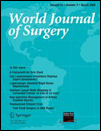A Prospective Randomized Trial Comparing Traditional and Fast-Track Patient Care in Elective Open Infrarenal Aneurysm Repair
This work was presented in part at the annual meeting of the German Society of Surgery, Surgical Forum 2008, Berlin, and was published as Best of Abstracts in Langenbeck’s Archives of Surgery (Langenbecks Arch Surg (2008) 393:281–287).
Abstract
Background
Fast-track recovery programs have led to reduced patient morbidity and mortality after major surgery. In terms of elective open infrarenal aneurysm repair, no evidence is available about such programs. To address this issue, we have conducted a randomized prospective pilot study.
Methods
The study involved prospective randomization of 101 patients with the indication for elective open aneurysm repair in a traditional and a fast-track treatment arm. The basic fast-track elements were no bowel preparation, reduced preoperative fasting, patient-controlled epidural analgesia (PCEA), enhanced postoperative feeding, and postoperative mobilization. Morbidity and mortality, need for postoperative mechanical ventilation, length of stay (LOS) in the intensive care unit (ICU) and total length of postoperative hospital stay were analyzed in terms of an intention to treat.
Results
Demographic data for the two groups were similar. In the fast-track group the need for postoperative ventilation was significantly lower (6.1% versus 32%; p = 0.002), the median LOS on ICU did not significantly differ (20 h versus 32 h; p = 0.183), full enteral feeding was achieved significantly earlier (5 versus 7 days; p < 0.0001), and the rate of postoperative medical complications—gastrointestinal, cardiac, pulmonary, renal, and infective—was significantly lower (16% versus 36%; p = 0.039). The postoperative hospital stay was significantly shorter in the fast-track group (10 days versus 11 days; p = 0.016); the mortality rate in both groups was 0%.
Conclusions
An optimized patient care program in open infrarenal aortic aneurysm repair shows favorable results concerning need for postoperative assisted mechanical ventilation, time to full enteral feeding, and incidence of medical complications. Further ranomized multicentric trials are necessary to justify broad implementation (clinical trials. gov identifier NCT 00615888).




